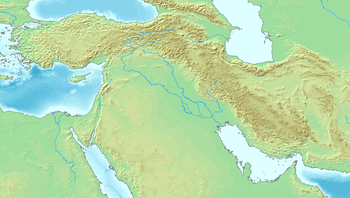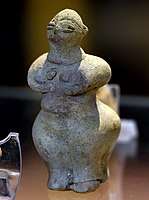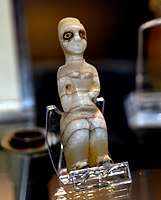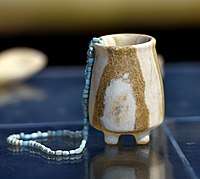Tell es-Sawwan
Tell es-Sawwan is an important Samarran period archaeological site in Saladin Province, Iraq. It is located 110 kilometres (68 mi) north of Baghdad, and south of Samarra.
Tell es Sawwan | |
|---|---|
 Tell es Sawwan Location in Iraq  Tell es Sawwan Tell es Sawwan (Iraq) | |
| Coordinates: 34°7′00″N 43°54′00″E |
The site is a primarily Ubaid, Hassuna, and Samarra culture occupation with some later Babylonian graves. It is considered the type site for the Samarran culture.
Tell es-Sawwan and its environment
Tell es-Sawwan is an oval mound 350 metres (1,150 ft) long by 150 metres (490 ft) wide with a maximum height of 3.5 metres (11 ft). The main mound was surrounded by a three-metre defensive ditch and a strong mudbrick wall. The village consisted of large houses and other buildings thought to be granaries.[1]
The inhabitants of Tell es-Sawwan were farmers who used irrigation from the Tigris to support their crops, as rainfall was unreliable. They used stone and flint tools similar to those of the Hassuna culture. Their prosperity, probably based on the dependability of irrigated crops, is evidenced by the presence of fine Samarran ware and beautiful, translucent marble vessels[1]
Underfloor graves of adults and children contained terracotta and alabaster statuettes of women and men, in various poses; some of these had the eyes and pointed heads typical of the Ubaid period.[1]
History of research
The site was excavated by a team from the Iraqi Directorate General of Antiquities in seven seasons between 1964 and 1971. The second season was led by Khalid Ahmad Al-a'dami and the sixth and seventh season by Walid Yasin.[2][3][4][5][6][7]
Gallery
 Female figurine from Tell es-Sawwan, Louvre Museum
Female figurine from Tell es-Sawwan, Louvre Museum Mother goddess from Tell es-Sawwan, Iraq, 6000-5800 BCE. Iraq Museum
Mother goddess from Tell es-Sawwan, Iraq, 6000-5800 BCE. Iraq Museum Mother goddess figurine from Tell es-Sawwan, Iraq, 6000-5800 BCE. Iraq Museum
Mother goddess figurine from Tell es-Sawwan, Iraq, 6000-5800 BCE. Iraq Museum Alabaster jar with a necklace from Tell es-Sawwan, Iraq. 6000-5800 BCE. Iraq Museum
Alabaster jar with a necklace from Tell es-Sawwan, Iraq. 6000-5800 BCE. Iraq Museum Bowl with human bones from Tell es-Sawwan, Iraq, 6000-5800 BCE. Iraq Museum
Bowl with human bones from Tell es-Sawwan, Iraq, 6000-5800 BCE. Iraq Museum
Notes
- "085. Tell es-Sawwan (ancient name unknown)". US Department of Defense. Retrieved 28 March 2014.
- F. el-Wailly and B. Abu Al-Soof, The Excavations at Tell es-Sawwan: First Preliminary Report (1964), Sumer , vol. 21, pp. 17-32, 1965
- Khalid Ahmad Al-a'dami, Excavations at Tell es-Sawwan (Second Season), Sumer, vol. 24, pp. 57-95, 1968
- Ghanim Wahida, Excavations at Tell es-Sawwan (Third Season) 1966, Sumer, vol. 23, pp. 167-178, 1967
- Behnam Abu Al-souf, Tell es-Sawwan: Excavation of the Fourth Season (Spring 1967), Sumer, vol. 24, pp. 3-15, 1968
- Behnam Abu Al-soof, Tell es-Sawwan: Fifth Seasons Excavations (Winter 1967, 1968), Sumer, vol. 27, pp. 3-7, 1971
- Walid Yasin, Excavation at Tell es-Sawwan - the Sixth Season (1969), Sumer, vol. 26, pp. 3-20, 1970
Further reading
- Abdul Qadir al-Tekriti, The Flint and Obsidian Implements of Tell es-Sawwan, Sumer, vol. 24, pp. 53–36, 1968
- Keith Flannery and Jane C. Wheeler, Animal Bones From Tell as-Sawwan Level III (Samaran Period), Sumer, vol. 23, pp. 179–182, 1967
- Donny George Youkana, Tell Es-Sawwan: The Architecture of the Sixth Millennium BC, NABU, 1997, ASIN B001AC6TMA ISBN 978-1-897750-05-6
- H Helbaek, Early Hassunan vegetable food at Tell es-Sawwan near Samarra, Sumer, vol. 20, 1966
- C. Breniquey, Rapport sur deux campagnes de fouilles à Tell es-Sawwan, 1988-1989, Mesopotamia, vol. 27, pp. 5–30, 1992
- F. Strika, Clay human figurines with applied decoration from Tell Es-Sawwan, Mesopotamia, vol. 33, pp. 7–21, 1998
- Joan Oates, The Baked Clay Figurines from Tell es-Sawwan, Iraq, vol. 28, no. 2, pp. 146–153, 1966
- Liverani, Mario (2013). The Ancient Near East: History, Society and Economy. Routledge. p. 13, Table 1.1 "Chronology of the Ancient Near East". ISBN 9781134750917.
- Shukurov, Anvar; Sarson, Graeme R.; Gangal, Kavita (7 May 2014). "The Near-Eastern Roots of the Neolithic in South Asia". PLOS ONE. 9 (5): e95714. Bibcode:2014PLoSO...995714G. doi:10.1371/journal.pone.0095714. ISSN 1932-6203. PMC 4012948. PMID 24806472.
- Bar-Yosef, Ofer; Arpin, Trina; Pan, Yan; Cohen, David; Goldberg, Paul; Zhang, Chi; Wu, Xiaohong (29 June 2012). "Early Pottery at 20,000 Years Ago in Xianrendong Cave, China". Science. 336 (6089): 1696–1700. Bibcode:2012Sci...336.1696W. doi:10.1126/science.1218643. ISSN 0036-8075. PMID 22745428.
- Thorpe, I. J. (2003). The Origins of Agriculture in Europe. Routledge. p. 14. ISBN 9781134620104.
- Price, T. Douglas (2000). Europe's First Farmers. Cambridge University Press. p. 3. ISBN 9780521665728.
- Jr, William H. Stiebing; Helft, Susan N. (2017). Ancient Near Eastern History and Culture. Routledge. p. 25. ISBN 9781134880836.